You are using an out of date browser. It may not display this or other websites correctly.
You should upgrade or use an alternative browser.
You should upgrade or use an alternative browser.
V4 Wobbler
- Thread starter Ken I
- Start date

Help Support Home Model Engine Machinist Forum:
This site may earn a commission from merchant affiliate
links, including eBay, Amazon, and others.
When I hit 60 I might try something with that many parts, Age and treachery get the job done, and well at that.
Robert
Robert
- Joined
- Dec 2, 2008
- Messages
- 971
- Reaction score
- 9
Nice job Ken. I had serious doubts about the magnets but your success is obvious. Congratulations.
Jerry
Jerry
spuddevans
Well-Known Member
- Joined
- Feb 25, 2008
- Messages
- 203
- Reaction score
- 1
Well done Ken :bow: :bow:
I must get on with my build now.
Tim
I must get on with my build now.
Tim
Thanks guys.
I had been thinking of a V4 wobbler for some time but couldn't see my way around the springs until Spudevans suggested magnets.
Chuck, I found a couple of discarded 8mm diameter x 5mm long Neodynium magnets from my other hobby - slotcars. These are used in Ninco 1/32 scale cars to hold them down to the steel conductors (barbaric) in home sets - but are discarded for raceing on wooden tracks with copper conductors.
Ah-Ha - the whole design evolved around those.
I also had reservations as to the magnet idea & dummied up the trunnion assembly prior to committing to a full build. Those cheap black ferrite fridge magnets won't cut it.
I'm not quite finished yet - now that it works I'm going to add a reversing / throttle valve to the top.
Once that's done I'll post it under finished projects and upload the detailed drawings and build notes (if anyone's interested).
Captin Jerry - my improbability drive didn't work due to a damn fool error in the design - I can & will fix it (I hope) but that's another post.
Regards,
Ken
I had been thinking of a V4 wobbler for some time but couldn't see my way around the springs until Spudevans suggested magnets.
Chuck, I found a couple of discarded 8mm diameter x 5mm long Neodynium magnets from my other hobby - slotcars. These are used in Ninco 1/32 scale cars to hold them down to the steel conductors (barbaric) in home sets - but are discarded for raceing on wooden tracks with copper conductors.
Ah-Ha - the whole design evolved around those.
I also had reservations as to the magnet idea & dummied up the trunnion assembly prior to committing to a full build. Those cheap black ferrite fridge magnets won't cut it.
I'm not quite finished yet - now that it works I'm going to add a reversing / throttle valve to the top.
Once that's done I'll post it under finished projects and upload the detailed drawings and build notes (if anyone's interested).
Captin Jerry - my improbability drive didn't work due to a damn fool error in the design - I can & will fix it (I hope) but that's another post.
Regards,
Ken

$45.99
Sunnytech Mini Hot Air Stirling Engine Motor Model Educational Toy Kits Electricity HA001
stirlingtechonline

$12.56
$39.95
Complete Plans for Building Horse Barns Big and Small(3rd Edition)
ThriftBooks-Atlanta

$94.99
$109.99
AHS Woodmaster 4400 Maintenance Kit for Outdoor Wood Boiler Treatment
Alternative Heating & Supplies

$99.99
AHS Outdoor Wood Boiler Yearly Maintenance Kit with Water Treatment - ProTech 300 & Test Kit
Alternative Heating & Supplies

$89.99
Outdoor Wood Boiler Water Treatment Rust Inhibitor- AmTech 300 & Test Kit
Alternative Heating & Supplies

$39.99
$49.99
Sunnytech Low Temperature Stirling Engine Motor Steam Heat Education Model Toy Kit For mechanical skills (LT001)
stirlingtechonline

$24.99
$34.99
Bowl Sander Tool Kit w/Dual Bearing Head & Hardwood Handle | 42PC Wood Sander Set | 2" Hook & Loop Sanding Disc Sandpaper Assortment | 1/4" Mandrel Bowl Sander for Woodturning | Wood Lathe Tools
Peachtree Woodworking Supply Inc

$39.58
$49.99
Becker CAD 12 3D - professional CAD software for 2D + 3D design and modelling - for 3 PCs - 100% compatible with AutoCAD
momox Shop

$519.19
$699.00
FoxAlien Masuter Pro CNC Router Machine, Upgraded 3-Axis Engraving All-Metal Milling Machine for Wood Acrylic MDF Nylon Carving Cutting
FoxAlien Official
![DreamPlan Home Design and Landscaping Software Free for Windows [PC Download]](https://m.media-amazon.com/images/I/51kvZH2dVLL._SL500_.jpg)
$0.00
DreamPlan Home Design and Landscaping Software Free for Windows [PC Download]
Amazon.com Services LLC
Chuck,
Attached cross section showing magnet and trunnions with 0.5mm clearance between trunnion & magnet - this seem to give the right amount of hold down force.
Ken

Attached cross section showing magnet and trunnions with 0.5mm clearance between trunnion & magnet - this seem to give the right amount of hold down force.
Ken

Chris B - thanks for the compliment but beautiful is probably pushing it.
I tend to design functional (read pug ugly) I think I was born without an asthetics chip - probably explains my lack of dress sense (according to SWMBO).
This is the reversing valve / throttle I am planning on adding to the V4 wobbler before mounting it on a wooden presentation base and then I will call it completed.
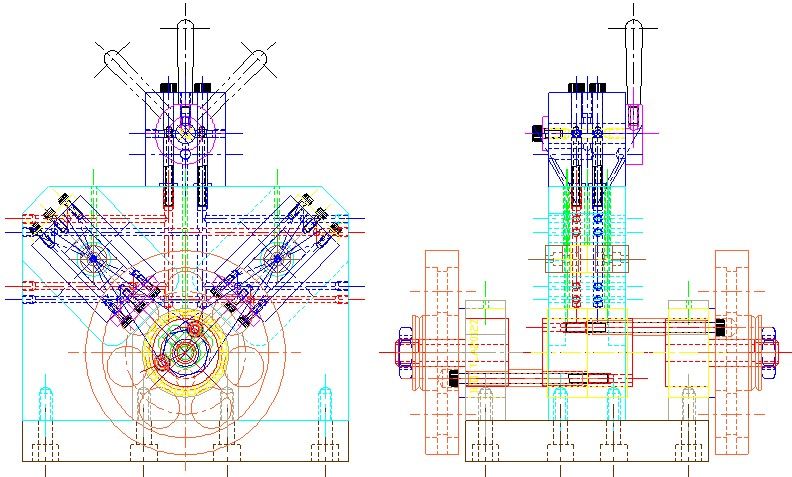
If it looks like an afterthought add on - that's precisely because it is.
Ken
I tend to design functional (read pug ugly) I think I was born without an asthetics chip - probably explains my lack of dress sense (according to SWMBO).
This is the reversing valve / throttle I am planning on adding to the V4 wobbler before mounting it on a wooden presentation base and then I will call it completed.

If it looks like an afterthought add on - that's precisely because it is.
Ken
Well here's the magnetically coupled V4 Wobbler - as completed as its going to get.
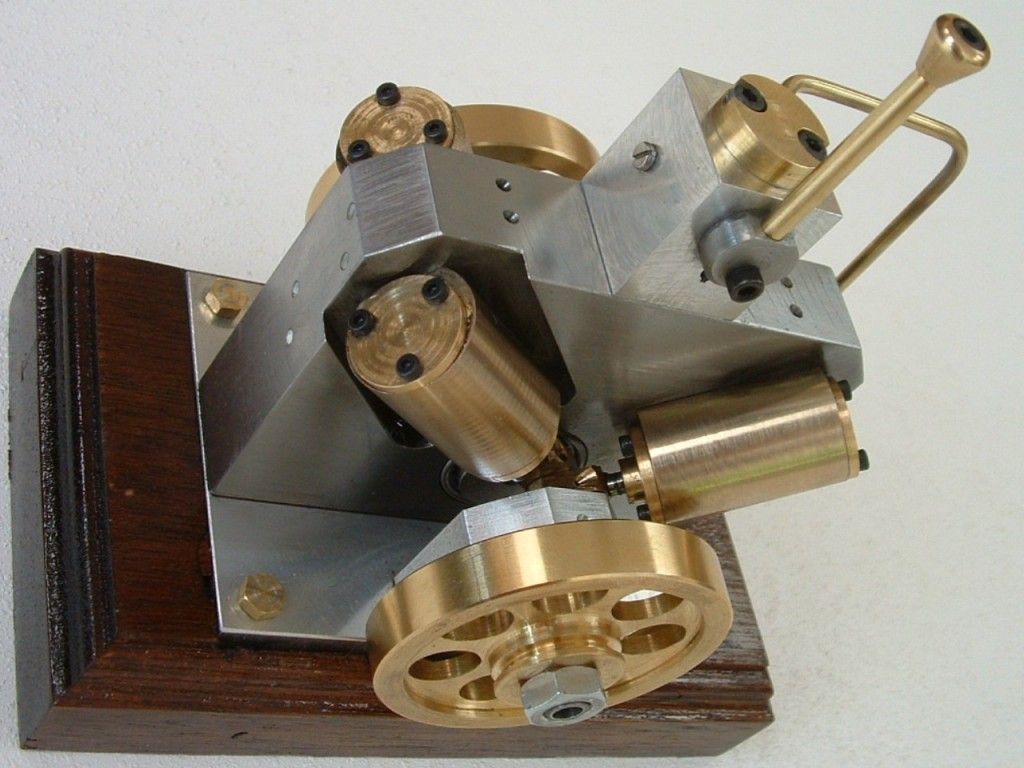
This whole engine came about due to a suggestion of "Spudeveans" about using magnets instead of springs to hold the cylinders in place and my spying some surplus &8x5 Neodynium magnets - the rest followed.
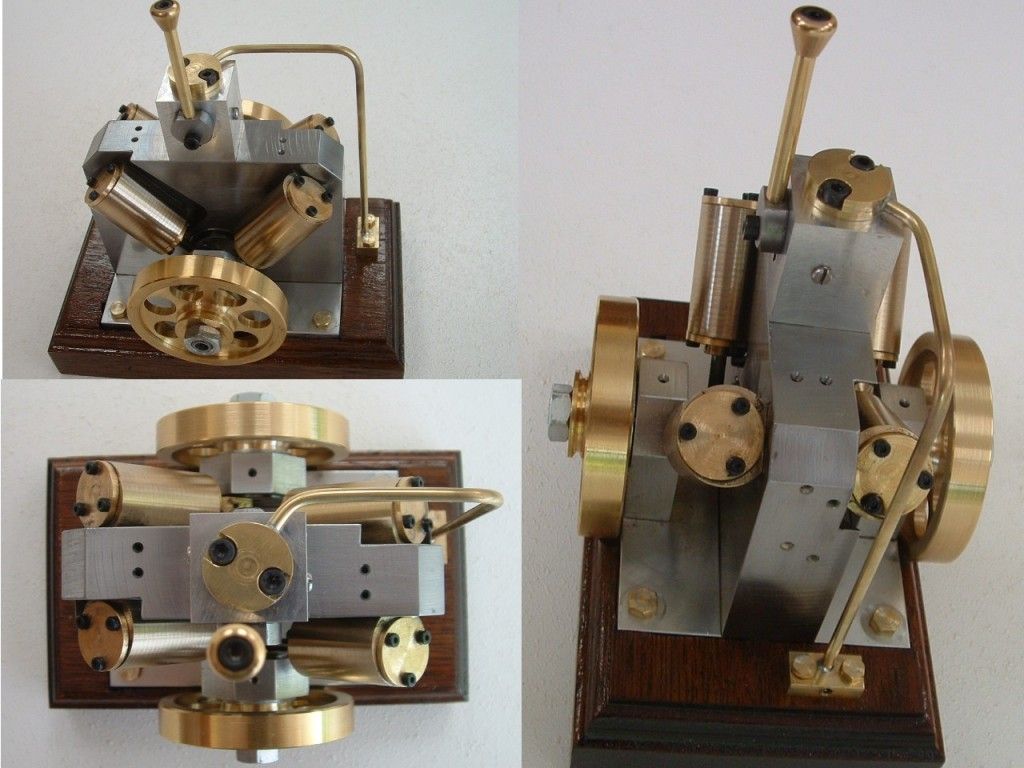
Being a double acting V4 there are 8 power strokes per revolution (&10x15 stroke) - by putting the cylinders at 90° and the big end wrist pins at 135° the motor gives 8 equispaced power strokes (if the wrist pins were at 90° or 180° it would give 4 double power strokes) this makes for a very smooth running, self starting motor which can run very slowly - which is nice for seeing the action.
Here's a video of it running :-
[ame=http://www.youtube.com/watch?v=JYZCwUKFoVw]http://www.youtube.com/watch?v=JYZCwUKFoVw[/ame]
I have posted a *.zip file under "Plans" which contains an ACAD 2D drawing, a *.DXF file of the drawing and a *.doc file of the build log and instructions, comments, suggestions etc.
The drawing has the various parts in different layers / colours - so by switching the layers on and off you can see where it goes relative to the rest.
There are detailed drawings of all the parts.
Heres the link to the upload :-
http://www.homemodelenginemachinist.com/index.php?action=tpmod;dl=item361
Ken

This whole engine came about due to a suggestion of "Spudeveans" about using magnets instead of springs to hold the cylinders in place and my spying some surplus &8x5 Neodynium magnets - the rest followed.

Being a double acting V4 there are 8 power strokes per revolution (&10x15 stroke) - by putting the cylinders at 90° and the big end wrist pins at 135° the motor gives 8 equispaced power strokes (if the wrist pins were at 90° or 180° it would give 4 double power strokes) this makes for a very smooth running, self starting motor which can run very slowly - which is nice for seeing the action.
Here's a video of it running :-
[ame=http://www.youtube.com/watch?v=JYZCwUKFoVw]http://www.youtube.com/watch?v=JYZCwUKFoVw[/ame]
I have posted a *.zip file under "Plans" which contains an ACAD 2D drawing, a *.DXF file of the drawing and a *.doc file of the build log and instructions, comments, suggestions etc.
The drawing has the various parts in different layers / colours - so by switching the layers on and off you can see where it goes relative to the rest.
There are detailed drawings of all the parts.
Heres the link to the upload :-
http://www.homemodelenginemachinist.com/index.php?action=tpmod;dl=item361
Ken
Ken great build, enjoyed very much, how does one get a way to read the DXF file, not to sharp on that, thanks for the help from someone, Lathe Nut
A couple of programs you can try:
http://download.chip.eu/en/Free-DWG-Viewer_3807257.html
http://www.digitaldatasolutions.co.uk/files/Solidworks/
Don't worry, they are Free!
Dave
The Emerald Isle
http://download.chip.eu/en/Free-DWG-Viewer_3807257.html
http://www.digitaldatasolutions.co.uk/files/Solidworks/
Don't worry, they are Free!
Dave
The Emerald Isle
Richard Hed
Well-Known Member
- Joined
- Nov 23, 2018
- Messages
- 2,760
- Reaction score
- 737
This is almost 10 years later from your post. Do you have an ER chuck now? The ER chucks are one of my priorities. I have finished an ER 25, am currently finishing up a 32 and have the stock ready for a 40 and a 50. I just discovered the 50 and bought the nut but had a difficult time finding any actual collets. Found some expensive ones--ones that retired person's budget cannot stretch to--then finally found a single vendor with "China-like" prices.Got the four cylinder assemblies finished.
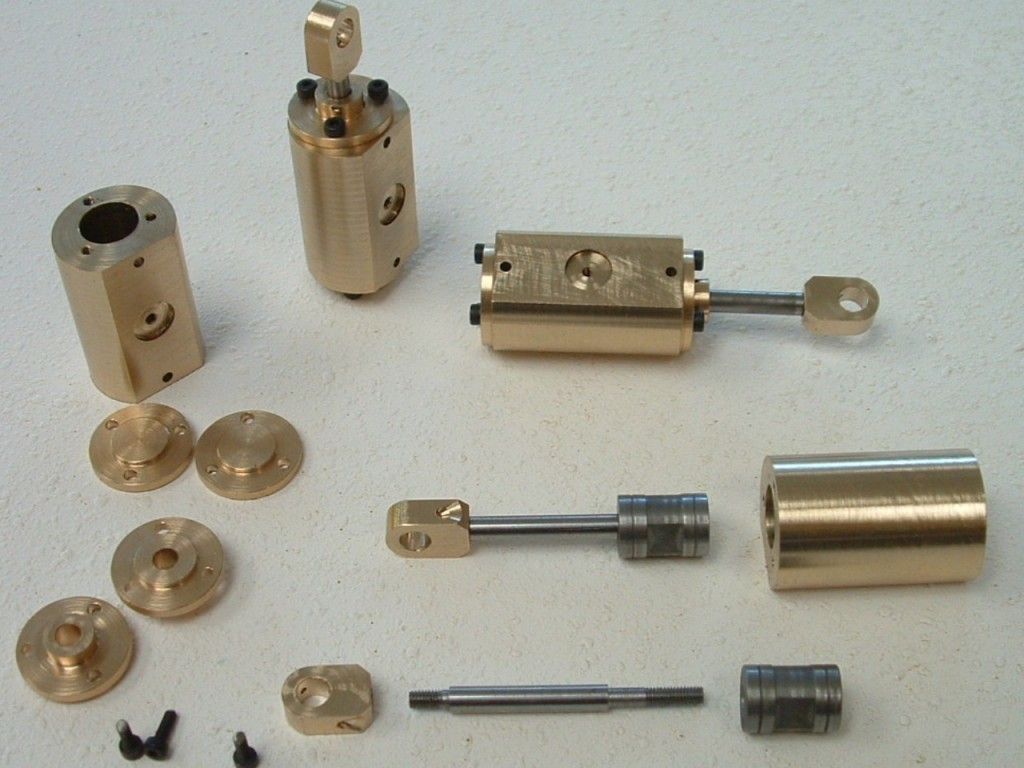
I "cheated" the three drilled holes in the cylinder heads by simply placing them on the cylinder at the last drilling & tapping position (last post) and spot drilled the head in-situ. I then drilled the spot 2mm on my drilling machine and returned it to the cylinder - fitted it in place with a M2 cap screw, 120° out and spot drilled the next hole etc. etc. - saved on having to mount and pitch drill each one.
Made the big ends from the smallest barstock possible by first drilling and reaming the bore eccentrically on the lathe with the 4 jaw.
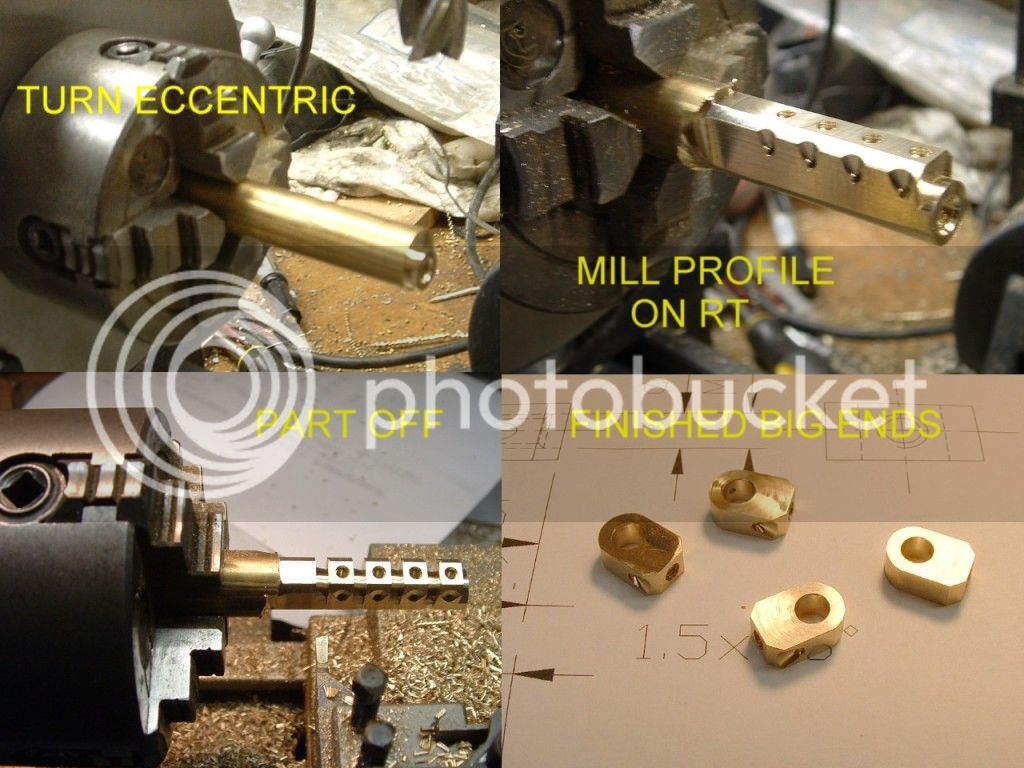
Then transplanted the 4 jaw to the rotary table and milled the profile and drilled the holes. Back to the lathe for parting off.

Since I don't have an ER collet chuck I turned the rods in a drill chuck I have mounted on a shank (an old shockabsorber rod which has the correct 1/2"20 UNF thread - practically made for the job) mounted in my 4 jaw.
Next job the main body which is a maze of cross drilled holes.
Ken
Richard Hed
Well-Known Member
- Joined
- Nov 23, 2018
- Messages
- 2,760
- Reaction score
- 737
Have you eveer taken apart an old hard drive and retrieved the magnet? There is a metal, must be glued, I suppose, that is about 2mm thick on the magnet. The odd thing is that the magnetism does not penetrate that metal. So one ends up with a magnetic part that is magnetic on one side only. (To this point, I only knew about one material which is "anti-magnetic", which I thimk is Bismuth, used to be about 60$/kilo.) I'm thimking, one could use a piece of that metal, maybe, to isolate the magnets from the iron or steel. Might work.The main body is mild steel with bronze bushes for the trunnions, the magnet is a press fit in the bronze to help isolate it magnetically from the body.
The drilling will also be tedious and I will need to be very carefull at the breakthrough points - I'm thinking of pushing a wire through the cross hole to prevent snatching as the drill goes through.
Anybody got any comments on that ?
Regards,
Ken
Similar threads
- Replies
- 5
- Views
- 2K
- Replies
- 2
- Views
- 11K
















































